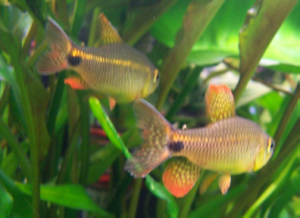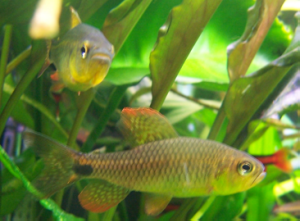Problem feeding sailfin tetras 05/25/09
Hello, WetWebMedia crew. I have a question concerning sailfin tetras
(Crenuchus spilurus). They are a rather rare fish in the aquarium
trade, so there isn't a lot of information online.
<Fortunately there is ample information in the better aquarium
books. One problem with online sources is they're mostly written by
casual amateurs rather than experts, so the fish they write about are
the commonly kept species. If you're even semi-serious about
fishkeeping, you owe it to yourself to buy a copy of a fishkeeping
"bible"; my vote would be for the excellent Baensch's
Aquarium Atlas Volume 1.>
My problem is that they aren't successfully competing for food in a
community tank.
<They won't. This species is best kept in a single species
aquarium.>
They share a 32 gallon, heavily planted tank with lots of Pencilfish,
an SAE, and a keyhole cichlid.
<Pencilfish should be okay, but the others are more or less chancy,
depending on what other foods are offered to them as well.>
When I drop food in the tank, the other fish will gobble it up rapidly
and ravenously while the sailfin tetras will either hang back and
watch, or not swim out of the plants until several minutes after all
the food has been eaten. The problem isn't the food, because when I
kept the Sailfins in a quarantine tank they ate everything I put in
there - New Life Spectrum flakes, bloodworm, and Spirulina pellets. I
think the problem is their method of feeding: since they are ambush
predators in the wild, they seem to need to stalk their food a little
bit, even flakes, before lunging at it with their huge mouths.
Unfortunately, by the time they are done stalking in a community tank,
the food is gone.
<Crenuchus spilurus will not eat dry food; live foods only, and wet
frozen foods once acclimated and trained to take whatever food you
offer.>
I've been getting around this somewhat by waiting until after the
main feeding, when they typically come up and hang under the surface,
and feeding them directly. It's fun to watch them feed, but
it's a bit of work over the long term. I'm wondering if you
could recommend a food that would be appropriate for them.
<Live Daphnia and mosquito larvae are the ideal; they have rather
large mouths given their size, and adult fish will take relatively big
prey, up to things like small earthworms, even livebearer fry.>
I'm thinking that it should be too large for Pencilfish to swallow,
and would remain semi-solid in water for a sustained period of time,
without sinking to the bottom. If you have any other suggestions for
resolving this problem, I'd appreciate hearing them.
<This isn't a sociable species as you probably know, and males
are territorial. Most aquarists keeping them simply maintain pairs in
small (8-10 gallon) tanks on their own, perhaps with a few shrimps or
snails as well, depending on whether or not breeding is an issue.
Assuming the tank is well planted, they aren't nervous fish, and
once settled, should consume live foods readily.>
Thanks for your time,
David
<Cheers, Neale.>
Re: Problem feeding sailfin tetras 05/27/09
Thanks for the swift reply. You're very right that the SAE and the
keyhole cichlid are the risky ones as far as competition with the
sailfin tetras.
Anything I put in there specially for the crenuchus spilurus will
likely be eaten by the latter two. The SAE is the worst offender.
I've already been taking photos of the SAE with the intent of
selling him online. I'm somewhat attached to the keyhole cichlid.
I'll have to think about what to do there. I've heard of the
Baensch Atlas - the section on crenuchus spilurus is online as one of
the sample pages provided by Google Books. I wish they had it as an
e-book, it's so huge. I loved the section on characins. I'm a
bit of a characin nut. I'll see if I can get a used copy.
<Good.>
In the meantime, maybe I'll move the sailfin tetras back to the
quarantine tank for now, at least until I can unload the SAE. They were
doing very well there, and I'm sure I can find some mosquito larvae
at this time of year. However, I do disagree with you on one thing:
they readily eat flake.
<Eat, perhaps... thrive on it, no. A lot of fish will eat a wide
variety of foods, and while flake may be useful, I'd still be
augmenting their diet with live foods or at least wet frozen.>
They were in the store for a month and a half before I bought them, and
I suppose the ones that didn't eat flake didn't make it.
<!!!>
It helps that the flake blows around in the filter outflow and kind of
looks alive.
<Yes.>
In sum, they are a very interesting and lively fish. They have
personalities, just like my keyhole cichlid, and when they extend their
fins like a switchblade, it's a real sight to see.
Thanks again,
David
<Cheers, Neale.>
|
Re: problem feeding Sailfin tetras
6/13/09
I just thought I'd update you on this, since there's not
a lot of info out there on Crenuchus spilurus. I've also
attached a couple of photos of my two male Sailfin tetras.
<And very handsome they are, too!>
Note that they look quite different from the ones pictured on
your website.
Yours perhaps come from Guyana? I'm 80% certain that mine
were imported from Iquitos, Peru, because that's where my LFS
gets almost all its South American shipments from. My coral red
pencilfish are from the same area.
<Fair enough.>
I'm happy to report that they are successfully competing for
flakes now, but you're right that these guys need live or wet
food. They really respond well to it. I had been feeding them
frozen bloodworms occasionally since I got them, but I upped the
feedings after our last communication (my attempt to find
mosquito larvae in standing water has thus far been an abject
failure). They can gulp down a LOT of bloodworms in one giant
clump.
<Agreed; these are greedy fish!>
They can eat so many at one feeding that I was honestly afraid
they'd get sick or burst. They didn't. I also made an
interesting observation: after a good feeding of flakes, the
males will display and spar for a while at the top of the tank,
just like pencilfish. After a good feeding of bloodworms,
however, they'll do a much more intense display, and in
addition to displaying and nipping each other, they'll puff
out their lower jaws in such a way that they look positively
monstrous. They only do it for a few seconds until the dominant
male establishes himself, and the other deflates. Having seen
this weird contortion, I suspect that their oversized mouths are
partly for display, rather than dietary purposes.
<May well be; your observations certainly seem to hint at
that. Wild fish are said to feed almost entirely on insect
larvae, rather than small fish, so they do seem to have rather
bigger mouths that would seem necessary!>
I also went back to the LFS just to look around, and discovered
that the tank with Sailfin tetras is still there. They've
been there for well over two months now. Clearly they are tough
fish, but no one is buying them because they are all pale and
moping at the bottom. I couldn't resist buying two more,
partly because I like them, and partly as a rescue mission. I
think they are both females, but one may turn out to be a
male.
The females are really drab.
<Often the case; there's some good evidence that female
fish deliberately select males with bright colours since those
are the ones most easily found and eaten by predators. Any male
that gets to sexual maturity must be smart and fast! The flip
side is that there's no such selection pressure on the
females, since males will mate with anything, so instead the
selection pressure on females is for camouflage.>
They got some colour back after a few days in quarantine and are
looking pretty good. The one odd thing right now is that they
seem to prefer flakes to bloodworms. Initially, they wouldn't
eat bloodworms at all, but now they'll eat a few at a time. I
also give them 1mm cichlid pellets. I'll see how it goes.
<I do find that Hikari Mini Pellets are taken by very many
fish that ignore flake point-blank, so it's worth
experimenting. If you can get fish weaned onto flake or pellet
foods, that makes is easier to ensure they'll get all the
vitamins and minerals they need, so it's well worth
doing.>
Thanks for your advice, and for all the interesting characin
articles.
- David
<Thanks for sending along these gorgeous photos! Crenuchus
spilurus is a criminally underrated species that, as you've
seen, has colours and personality that matches anything else in
the hobby of this size, whether
freshwater or marine. Cheers, Neale.>
|
  |
|
|

